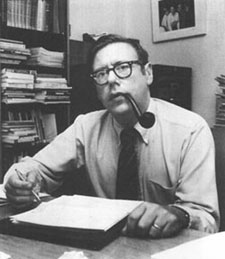Arthur Melvin Okun facts for kids
Quick facts for kids
Art Okun
|
|
|---|---|
 |
|
| 7th Chair of the Council of Economic Advisers | |
| In office February 15, 1968 – January 20, 1969 |
|
| President | Lyndon Johnson |
| Preceded by | Gardner Ackley |
| Succeeded by | Paul McCracken |
| Personal details | |
| Born |
Arthur Melvin Okun
November 28, 1928 Jersey City, New Jersey, U.S. |
| Died | March 23, 1980 (aged 51) Washington, D.C., U.S. |
| Political party | Democratic |
| Education | Columbia University (BA, MA, PhD) |
| Academic career | |
| Institution | Yale University |
| Field | Macroeconomics |
| School or tradition |
Neo-Keynesian economics |
| Doctoral advisor |
Arthur F. Burns |
| Influences | John Maynard Keynes |
| Contributions | Okun's law Misery index |
Arthur Melvin "Art" Okun (born November 28, 1928 – died March 23, 1980) was an important American economist. He helped the U.S. government understand the economy. From 1968 to 1969, he was the chairman of the Council of Economic Advisers. This is a group that gives economic advice to the President of the United States. Before this job, he taught at Yale University. After his government role, he worked at a research center called the Brookings Institution.
In 1968, he was chosen as a Fellow of the American Statistical Association. This means he was recognized for his important work in statistics.
Contents
What is Okun's Law?
Okun is most famous for an idea called Okun's law. It's a simple rule that shows a connection between how many people have jobs and how much a country produces.
- Imagine a country's economy is like a big factory. Its "potential" is how much it could produce if everyone who wanted to work had a job. This is called its potential GDP (Gross Domestic Product).
- Okun's law says that if the number of people without jobs (the unemployment rate) goes up by 1%, then the country's actual production (its GDP) will be about 2.5% lower than what it could be.
- So, if more people are unemployed, the country makes less stuff and earns less money. This law helps economists guess how much the economy might shrink if unemployment rises.
The Misery Index
Okun also created something called the misery index. This index is a simple way to measure how "miserable" people might feel about the economy.
- It adds together the unemployment rate and the inflation rate.
- Inflation is when prices for things like food and clothes go up.
- When both unemployment and inflation are high, people might feel more "miserable" because it's hard to find a job and everything costs more.
The Leaky Bucket Analogy
Another idea Okun is known for is his "leaky bucket" analogy. He used it to explain the idea of deadweight loss in economics.
- Imagine the government wants to give money to people who need it. This is like filling a bucket with water to carry it to someone.
- But if the bucket has holes (like taxes or other costs), some water leaks out along the way.
- The "leaky bucket" shows that when the government tries to move money around (for example, through taxes and benefits), some of that money can be lost or used up in the process. It doesn't all reach its intended goal.
Okun's Education and Early Career
Art Okun went to Columbia College and graduated in 1949. He was a very good student and won an award for having the highest grades. He then continued his studies at Columbia University, earning a PhD in economics in 1956. After finishing his education, he began teaching at Yale University.
He passed away on March 23, 1980, due to a heart attack.
Works
- Equality and Efficiency: The Big Tradeoff (1975): In this book, Okun explored the challenge of balancing economic equality (everyone having similar wealth) with economic efficiency (making the most out of resources).
- Prices and Quantities: A Macroeconomic Analysis (1981): This book was published after his death and looks at how prices and the amount of goods produced affect the overall economy.
See also
- Okun's law

